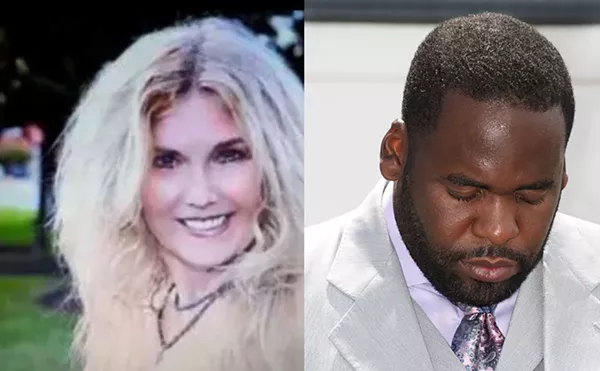
Audio By Carbonatix
[
{
"name": "GPT - Leaderboard - Inline - Content",
"component": "35519556",
"insertPoint": "5th",
"startingPoint": "3",
"requiredCountToDisplay": "3",
"maxInsertions": 100,
"adList": [
{
"adPreset": "LeaderboardInline"
}
]
}
]
Trained in the ’80s, I learned to be skeptical of representation. But Julie Heffernan can really paint. That alone would be insufficient, but her virtuosity is married to idiosyncratic vision. Old Master figures, Renaissance landscape perspective, and the convincing illusion of Dutch genre painting combines in an effect-driven mannerism that feels natural. Then one feels the undertow of her personal symbols for contemporary issues of gender, class structure, psychological uncertainty and her expansive knowledge of painting’s history.
Her large paintings begin as self-portraits, resembling the heroines of Pre-Raphaelite painter-poet Rossetti, with full lips, aquiline nose and elongated limbs. She is an allegorical trophy wife, her primary task to look stunning, dripping with jewels and surrounded by flowers. Thanks to her fecund eroticism, certainly less repressed than Rossetti’s, she is not rendered powerless. She is a force of nature. In “Self-Portrait in Swamp Water,” her image gazes at the viewer directly while her ring finger penetrates the juicy interior of a pomegranate through a slit in the skin. She is surrounded by luscious fruit hanging heavy in the branches, coral reef fish swimming around her thighs and mysterious faces emerging through the surface of fruit as other facets of self. As you fall into the seduction, you can smell the swamp.
In “Self Portrait with Birds in My Fingers,” our subject is a little better behaved, wearing her tutu of roses and surrounded by exotic birds flying around her head within the stylized fleur-de-lis of a medieval tapestry. But those birds between her fingers are looking stressed, trapped as they are and symbols of her own predicament, as a city burns in the lower left. She pushes the beauty issue the furthest in “Self-Portrait as Gorgeous Tumor II,” the jeweled chandelier headdress overwhelming the scale of her prepubescent body. Her latent sexuality is suggested in the shadowy background of large exotic animals — hippos, alligators, lions — combined with a parade of art history references such as St. George slaying the dragon. The lushly painted fruit refers to Dutch “vanitas” — still lifes — meant to serve as a reminder of how ephemeral life is and to offer hope for the eternal.
Some of these self-portraits read as heroic landscape paintings where all monument and myth of humankind are inconsequential next to the reproductive power of nature and its inexorable slide of entropy. In “Self-Portrait as Soft Target,” the entire burning city of architectural achievement (Arc de Triomphe, pyramids, etc.) fits under a tropical leaf. In “Self-Portrait as Weird Bush,” an arch of piled fruit occupies the center of the painting, framing a distant paradise with bathers where one figure is half-submerged as the other falls from the sky. Animals overtake the surface real estate — mostly white mice and birds — cavorting in the cultivated Italian Renaissance landscape. “Self-Portrait as Mound of Roses” includes her figure again, rendered very small with the foliage of a peacock, standing behind the mound of roses that a line of men wait to climb, including the mythical Pan with his pipe. This human drama occupies a small area below a smoking volcano and a small dirigible crashing, all exquisitely rendered.
Is the seduction of accomplished representational painting stronger today because of lowered expectations in the art world? Any academically trained painter or illustrator used to have technical skills, but in the ’80s and ’90s, with the stampede to new media and more politically expedient art forms, it became unfashionable to let these skills show — if learned at all. While a few realists like Vincent Desiderio continued to have New York shows in the ’90s, most were pushed to the margins. In Detroit, a post-Corridor generation of artists continued using representation, in particular Ed Fraga and Carl Demeulenaere doing landscape and figures respectively. By the late ’90s when New York artists such as John Currin began to show off their academic chops — as he tells the story — to stand out from the crowd, the response to his technical skills was unanimous breathless enthusiasm. And Heffernan (MFA, Yale, 1985) could not have been naive about art trends.
But fashion aside, the best reason to not miss this show is that Heffernan’s work loses its most transcendent element when seen in reproduction, and that is the sensuous fleshiness of the paint. It’s viscera for the imagination and holds her camp idiom in check. I haven’t spent a lot of time wondering what representational painting has done for us lately, but now my brain won’t let go of those fertile images.
Runs through June 25 at Robert Kidd Gallery, 107 Townsend St., Birmingham; 248-642-3909.
Gerry Craig is an artist and writer. Send comments to letters@metrotimes.com




